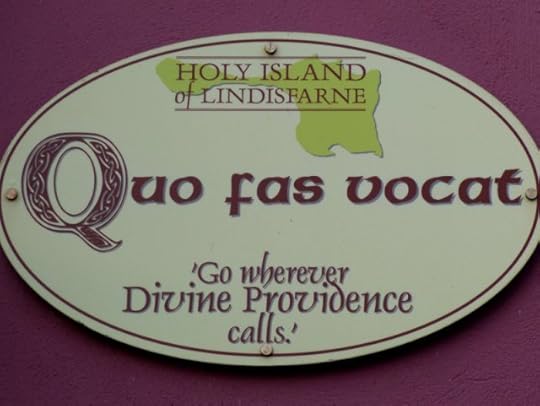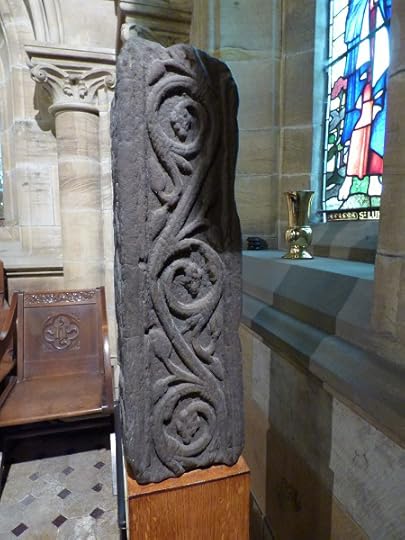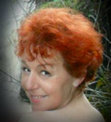Sue Vincent's Blog: Echoes of Life, page 1050
February 9, 2015
Discovering Albion – day 7: A tide of silence
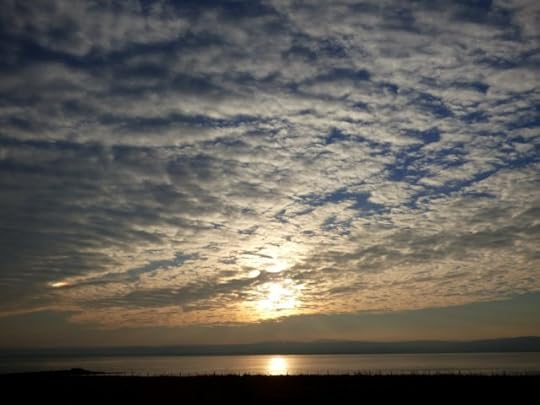 Winter on Holy Island, it seems, is silent save for the song of the waves and the cry of the gull. The visitors had left; the locals all seemed to be indoors. It was as if we shared the island only with the birds. Which meant, of course, that we were hugely outnumbered.
Winter on Holy Island, it seems, is silent save for the song of the waves and the cry of the gull. The visitors had left; the locals all seemed to be indoors. It was as if we shared the island only with the birds. Which meant, of course, that we were hugely outnumbered.
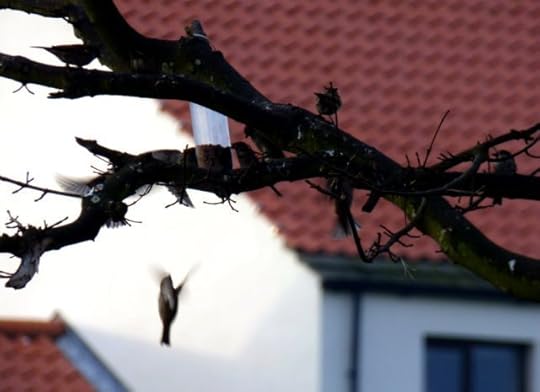 They were everywhere. Another robin, blackbirds and gulls… doves and sparrows. A posse of chickens ahead of us on the path… and of course, we had the kestrels. And that was without the mallards, the lapwings and the stealthy heron caught on camera sneaking along the line of a fence. He obviously thought he was in stealth mode…
They were everywhere. Another robin, blackbirds and gulls… doves and sparrows. A posse of chickens ahead of us on the path… and of course, we had the kestrels. And that was without the mallards, the lapwings and the stealthy heron caught on camera sneaking along the line of a fence. He obviously thought he was in stealth mode…
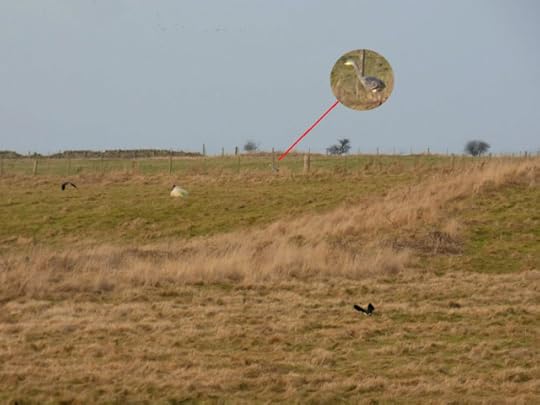 The place is a paradise for birdwatchers… and seals are common here too. But the fading light made it impossible to see if the movement in the waves were shadows or these creatures of the deep, and we felt that rather than watching the birds, they were watching us. We seemed to be constantly accompanied by feathered sentinels, and we went where they led and saw what they guided our gaze to see.
The place is a paradise for birdwatchers… and seals are common here too. But the fading light made it impossible to see if the movement in the waves were shadows or these creatures of the deep, and we felt that rather than watching the birds, they were watching us. We seemed to be constantly accompanied by feathered sentinels, and we went where they led and saw what they guided our gaze to see.
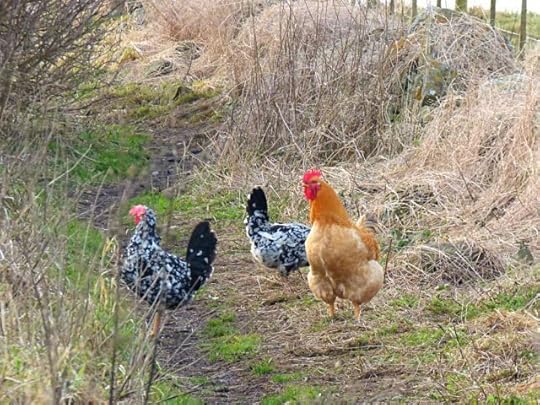 There was, for a little while, no other way to be. The waves had closed around Holy Island and a silence unknown on the mainland descended. We walked back to the pilgrim’s path and saw how the sea had taken both it and the road. It is a strange feeling, knowing there is no way back, even when it is only for a few hours. It is one I could get used to.
There was, for a little while, no other way to be. The waves had closed around Holy Island and a silence unknown on the mainland descended. We walked back to the pilgrim’s path and saw how the sea had taken both it and the road. It is a strange feeling, knowing there is no way back, even when it is only for a few hours. It is one I could get used to.
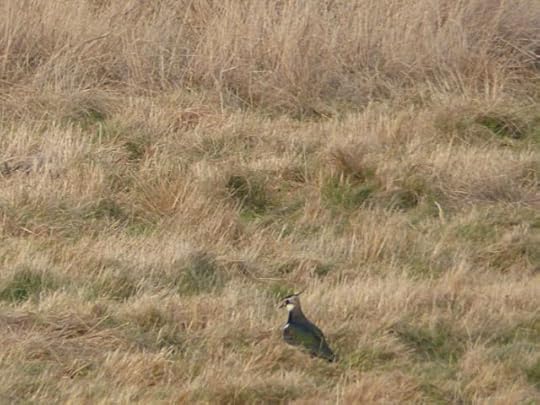 “I want to live on an island…”
“I want to live on an island…”
“You already do…” Well, yes, I know… but here I could walk from shore to shore in an hour at the pace of the sheep. It is easy to see why it had become a place of spiritual retreat very early in its history.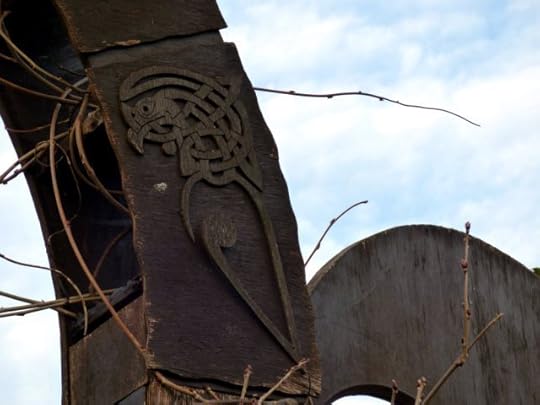 St Aidan was sent from Iona, the heart of Christianity in the north at that time, to found a small monastery on Lindisfarne around 634AD on land granted to him by King Oswald of Northumbria. He was succeeded as abbot on his death in 651 by Finan, and it was he who baptised Paeda, son of Penda, the last pagan king of Mercia thus bringing Christianity to the heart of the land.
St Aidan was sent from Iona, the heart of Christianity in the north at that time, to found a small monastery on Lindisfarne around 634AD on land granted to him by King Oswald of Northumbria. He was succeeded as abbot on his death in 651 by Finan, and it was he who baptised Paeda, son of Penda, the last pagan king of Mercia thus bringing Christianity to the heart of the land.
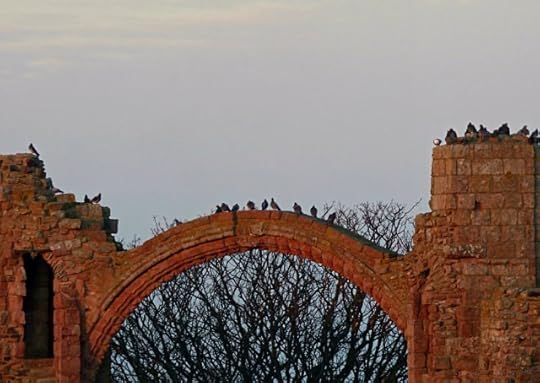 The monastery later passed to the care of St Cuthbert. He was born into a noble family around 634AD. Many stories of miracles grew around his life, giving him the title of Wonder Worker of Britain amongst the common people. He was known for his kindness and generous heart. He chose to live an ascetic life and withdrew from the world when he could to live in solitude.
The monastery later passed to the care of St Cuthbert. He was born into a noble family around 634AD. Many stories of miracles grew around his life, giving him the title of Wonder Worker of Britain amongst the common people. He was known for his kindness and generous heart. He chose to live an ascetic life and withdrew from the world when he could to live in solitude.
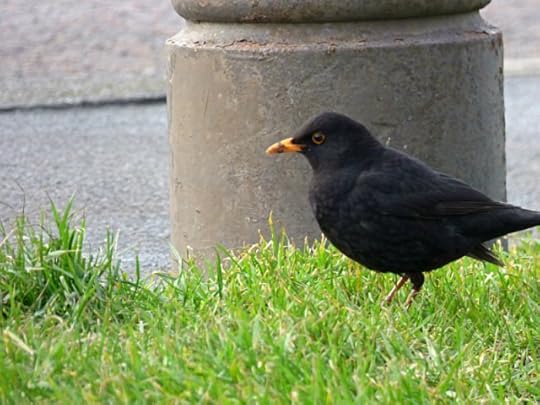 Just below where we would stand to watch the sunset if St Cuthbert’s Isle… a tiny rocky outcrop little bigger than a modern house. The remains of a chapel and the circular earthwork that may have been his home still stand in the shadow of a simple cross.
Just below where we would stand to watch the sunset if St Cuthbert’s Isle… a tiny rocky outcrop little bigger than a modern house. The remains of a chapel and the circular earthwork that may have been his home still stand in the shadow of a simple cross.
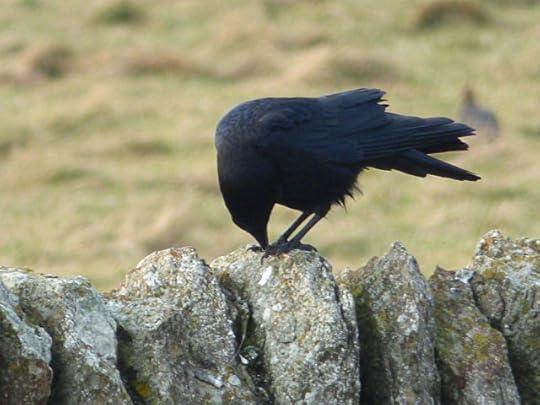 Strangely enough, St Cuthbert who had been born in the Borders through which we had driven, had also built a small hermitage in what is now St Andrews… where we had been the day before… and a shrine was raised to house his remains in Durham Cathedral. Although we didn’t yet know it, we would pay our respects there the next day.
Strangely enough, St Cuthbert who had been born in the Borders through which we had driven, had also built a small hermitage in what is now St Andrews… where we had been the day before… and a shrine was raised to house his remains in Durham Cathedral. Although we didn’t yet know it, we would pay our respects there the next day.
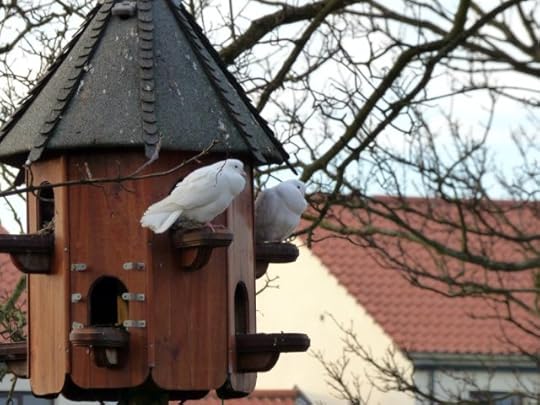 We watched the sea hold the island in its embrace and walked quietly to the little church that sits in the shadow of the ruined Priory. There is something about the place, when the sea opens and closes the doors to the world that invites quiet contemplation. We could feel why it was a perfect place for a monastery and why those who came as pilgrims long ago still came today. Even if their Path is not identical to our own, when there is nothing but the wind, the waves and the vault of the sky, divinity seems very close and touches the heart with its presence.
We watched the sea hold the island in its embrace and walked quietly to the little church that sits in the shadow of the ruined Priory. There is something about the place, when the sea opens and closes the doors to the world that invites quiet contemplation. We could feel why it was a perfect place for a monastery and why those who came as pilgrims long ago still came today. Even if their Path is not identical to our own, when there is nothing but the wind, the waves and the vault of the sky, divinity seems very close and touches the heart with its presence.
Caterpillar
Dancers
February 8, 2015
Discovering Albion – day 7: Out to the castle
 We had found a pub and, duly watered and warmed by the coal fire of the Crown and Anchor, had wandered out to look around. The tide was still out, but the few visitors were already making their way back to their cars. We walked out along the deserted path towards the castle, passing only the obligatory black dog and his owner on the way.
We had found a pub and, duly watered and warmed by the coal fire of the Crown and Anchor, had wandered out to look around. The tide was still out, but the few visitors were already making their way back to their cars. We walked out along the deserted path towards the castle, passing only the obligatory black dog and his owner on the way.
The history of the island goes back to the earliest times, with finds dating to right to Mesolitic times including a quarry for flint with which the sharp tools were made. There are many birds… both seabirds and the more familiar birds of the land. The light sparkles on the water, glittering motes more precious than jewels, born of sun and sea… the essence of the life of earth. There is always something quite primal in being on an island, and though Albion herself is an island we forget that readily when we live inland. Here we are reminded as the sea closes in behind us and we no longer have a choice whether we go or stay.
 We would have stayed the night, waking to dawn on the sea, but many places were closed, others expensive. Instead we would cross the causeway after dark. For now, though, the afternoon still waited to be explored. The castle loomed over us, perched upon its rock. It would be closed, but then, we had not come here to wander its rooms.
We would have stayed the night, waking to dawn on the sea, but many places were closed, others expensive. Instead we would cross the causeway after dark. For now, though, the afternoon still waited to be explored. The castle loomed over us, perched upon its rock. It would be closed, but then, we had not come here to wander its rooms.
 The castle was built around 1550 upon the highest point of the island, a hill called Beblowe. Many of its stones were taken from the Priory which had fallen into disuse. It had been the site of a previous fortification, but little more than turf ramparts it would seem. The castle was constructed and held a small garrison. It saw service in the Jacobite uprising and had eventually been used by the coastguard when it was found by publisher Edward Hudson, the owner of Country Life magazine.
The castle was built around 1550 upon the highest point of the island, a hill called Beblowe. Many of its stones were taken from the Priory which had fallen into disuse. It had been the site of a previous fortification, but little more than turf ramparts it would seem. The castle was constructed and held a small garrison. It saw service in the Jacobite uprising and had eventually been used by the coastguard when it was found by publisher Edward Hudson, the owner of Country Life magazine.
 Hudson engaged Sir Edwin Lutyens to refurbish the castle in the Arts and Crafts style and Gertrude Jekyll designed the gardens, making it a beautiful holiday home for its owner. Today it is in the care of the National Trust. In summer there is a steady stream of visitors climbing the steep slope to the gate.
Hudson engaged Sir Edwin Lutyens to refurbish the castle in the Arts and Crafts style and Gertrude Jekyll designed the gardens, making it a beautiful holiday home for its owner. Today it is in the care of the National Trust. In summer there is a steady stream of visitors climbing the steep slope to the gate.
 Over the water Bamburgh Castle is outlined in the haze and the tall stone obelisks of Guile Point guide boats into the little harbour. We stopped to watch another robin leading us onward it seemed, beyond the sheds made of upturned boats towards a small outcrop of rock that looks towards the open sea. We watched the water… for a while there was nothing else.
Over the water Bamburgh Castle is outlined in the haze and the tall stone obelisks of Guile Point guide boats into the little harbour. We stopped to watch another robin leading us onward it seemed, beyond the sheds made of upturned boats towards a small outcrop of rock that looks towards the open sea. We watched the water… for a while there was nothing else.
 Then a flash of movement caught my eye. I raised the camera, ever hopeful… and caught a kestrel hunting. Joined by its mate they flew over the roof of the castle, the pair silhouetted against the sky. Walking back towards the village I spotted one of them sitting on a post… then noticed its mate a few feet away. We watched them for a good while, with me inevitably snapping away. They too were watching…us.
Then a flash of movement caught my eye. I raised the camera, ever hopeful… and caught a kestrel hunting. Joined by its mate they flew over the roof of the castle, the pair silhouetted against the sky. Walking back towards the village I spotted one of them sitting on a post… then noticed its mate a few feet away. We watched them for a good while, with me inevitably snapping away. They too were watching…us.

Discovering Albion – day 7: Marooned
 For with the flow and ebb, its style
For with the flow and ebb, its style
Varies from continent to isle;
Dry shod o’er sands, twice every day
The pilgrims to the shrine find way;
Twice every day the waves efface
Of staves and sandalled feet the trace.
Sir Walter Scott
 We arrived an hour before the tide would come in, drowning both the causeway and the ancient pilgrim route that still crosses the sands and the mud flats. It would either be a flying visit where we would see little, or we could choose to wait until the tide went out, some eight hours later to leave Holy Island. The causeway would be lost beneath the sea and the Island would become itself for a while, cut off from the world and a place of utter peace at this time of year… We weren’t in a hurry.
We arrived an hour before the tide would come in, drowning both the causeway and the ancient pilgrim route that still crosses the sands and the mud flats. It would either be a flying visit where we would see little, or we could choose to wait until the tide went out, some eight hours later to leave Holy Island. The causeway would be lost beneath the sea and the Island would become itself for a while, cut off from the world and a place of utter peace at this time of year… We weren’t in a hurry.
 We parked the car and walked down to where we could see the castle. My companion had never visited Lindisfarne before and I had managed only the briefest of visits, always ruled by the tide and other obligations. This time we could explore. We drove slowly across the causeway. The sands and grasses of the dunes seem not to form a clear delineation between sea and shore and it seems odd to drive where you know there will soon be waves.
We parked the car and walked down to where we could see the castle. My companion had never visited Lindisfarne before and I had managed only the briefest of visits, always ruled by the tide and other obligations. This time we could explore. We drove slowly across the causeway. The sands and grasses of the dunes seem not to form a clear delineation between sea and shore and it seems odd to drive where you know there will soon be waves.
 This would be my first winter visit and therefore the first time I had seen the island itself. Normally there is the façade provided for tourist and pilgrim… for this is still a place of reverence, even today. There were very few people about, mostly the odd islander walking a dog or going quietly about their life in the unaccustomed silence. Holy Island was closed for the winter.
This would be my first winter visit and therefore the first time I had seen the island itself. Normally there is the façade provided for tourist and pilgrim… for this is still a place of reverence, even today. There were very few people about, mostly the odd islander walking a dog or going quietly about their life in the unaccustomed silence. Holy Island was closed for the winter.
 None of the little gift shops would open before February, the Scriptorium and museum were closed. But there was bound to be a pub open and that would be our first stop. We had eight hours to explore. It is not a big island… 3miles long by a mile and a half wide….but it has a history worth the telling and a rich and varied wildlife.
None of the little gift shops would open before February, the Scriptorium and museum were closed. But there was bound to be a pub open and that would be our first stop. We had eight hours to explore. It is not a big island… 3miles long by a mile and a half wide….but it has a history worth the telling and a rich and varied wildlife.
 Today around 160 people live on the island yet 650,000 people visit every year. Most visitors come in warmer weather and leave before the crossing is closed by the sea. I was glad we were here in winter and would stay while the sea came in. We almost had the island to ourselves it seemed, except for a solitary walker, who silently trod the pilgrim’s path.
Today around 160 people live on the island yet 650,000 people visit every year. Most visitors come in warmer weather and leave before the crossing is closed by the sea. I was glad we were here in winter and would stay while the sea came in. We almost had the island to ourselves it seemed, except for a solitary walker, who silently trod the pilgrim’s path.

Dear Don XV
I wish I’d left you copies of the photos… you should see the stones now that there is time to really consider them! I’m betting the lion slaying David has an alter ego… and I wonder how many of the accepted interpretations of figures could be reassigned to the myths of pagan streams?
We tend to forget that many of them were discovered in an age where piety wore a crucifix and admitted of no other valid faith. Anything non-Christian was pagan… and never the twain could meet, though certainly the papal mission had other ideas on that, as the letter to Mellitus shows.
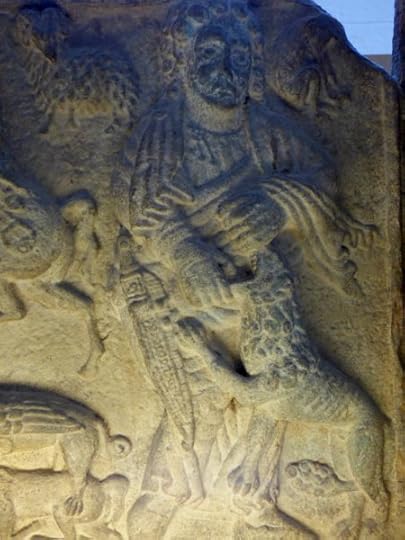
It is something we have come across often enough really… the ancient sites Christianised with shrine or church built upon the older places of faith… the churches with stone circles in their foundations, the hillforts topped with a chapel… We’ve been finding such places right from the start, with that very first trip out to Dashwood’s Hellfire caves and his church set within the hillfort above. The ORC the same day… and ancient site beneath the chapel, and ancient hillfort above… And while we realised that quite early on in our adventures I’m not sure we have even now fully understood the implications of that and how much else it brings into question.
 It is so easy to accept expert opinion though, isn’t it… even when the experts were speaking from a world constrained by less knowledge, less religious freedom and the shadow of heresy.
It is so easy to accept expert opinion though, isn’t it… even when the experts were speaking from a world constrained by less knowledge, less religious freedom and the shadow of heresy.
By Norman times I think things were less equivocal; the Church firmly established in power. But anything before that is perhaps worth looking at from a pagan perspective as much as the Christian.
We know… and there is enough history to back that up… that the early Ionian Christians took a more Druidic stance to the natural world and the mythologies still resonated and seemed able to stand side by side with faith. I wonder why it was that we felt a need to divorce ourselves from that and turn towards temporal power?
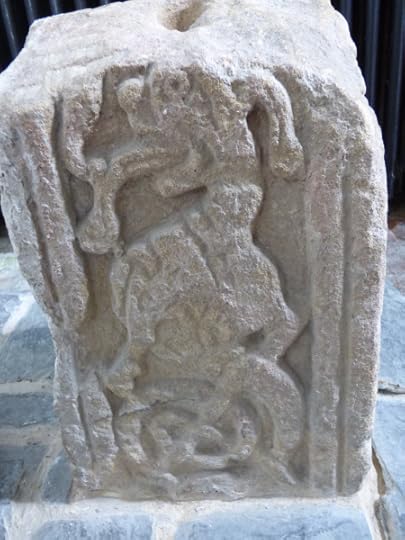 I’ve been thinking. Yes, I can hear exactly what you’re going to say there… But seriously. The medieval church was fraught with politics and the fight for personal power at the very top. If those with ambition to further their own ends actually believed in the Judgement and in the heaven and hell they portrayed to the people, then their own political shenanigans must have put the wind up their cassocks if they stopped to think about their own chances of making it to Heaven.
I’ve been thinking. Yes, I can hear exactly what you’re going to say there… But seriously. The medieval church was fraught with politics and the fight for personal power at the very top. If those with ambition to further their own ends actually believed in the Judgement and in the heaven and hell they portrayed to the people, then their own political shenanigans must have put the wind up their cassocks if they stopped to think about their own chances of making it to Heaven.
So maybe it was ostrich syndrome… bury their heads in the sand and hope … and maybe that is why we turned away from a message of Love for all creatures and for the earth? Or maybe it is just easier to control the masses through fear…
I, however, am currently being controlled by a tennis ball judiciously inserted in my boot again. Quite what the beast thinks can be achieved by this ploy I do not know… but it becomes persistent, as does the gaze of large, pathetic eyes…
I give in. I shall go and play ball.
Love,
Wen and Anu x

Ode to a dead office chair…
My dignity is damaged
Since the wheel fell off the chair
And sent me spinning backwards
With both feet up in the air.
There was that awful moment
When I knew I couldn’t stop
And wondered on which bit of me
The chair …and me… would drop.
I don’t do acrobatics
…Volunatrily… these days
The passing years and dodgy joints
Have made me mend my ways.
The wrist took most of the assault,
The hip most of the rest,
The dodgy spine did none too well…
The chair had come off best.
I lay there winded, wondering
If I should dare to move
And if I did I wondered
Just how painful it might prove.
The small dog had a panic
And ran over in alarm
To check to see I was okay
Or if I’d come to harm.
She didn’t know quite what to do,
But, glad I wasn’t dead,
She licked my face and just sat down
To guard the corpse instead.
The corpse looked at the ceiling
Feeling rather wan and faint…
Deciding it could do with
Yet another coat of paint.
My dignity is bruised today…
My posture’s not terrific.
Let’s say I need a cushion…
And let’s not be more specific…
So signing off with poetry…
A ditty, not an ode…
I plan to spend the afternoon
In horizontal mode.

February 7, 2015
Discovering Albion – day 7: Sea storms
 “Why is there a pyramid in the middle of East Lothian?” We’d both seen it before of course on our travels, but had never taken note in the way we do now that our adventures with the books have taught us so much. We knew it was close to North Berwick and I seemed to remember something being on top… Later research confirmed… North Berwick Law is a volcanic plug that stands some 613ft above sea level on the flat plain. It is topped with an iron age hill fort of some complexity and remains from the Napoleonic and World Wars. It is topped by an archway of whalebones… once authentic, now replaced with a fibreglass replica donated by a friend of the town. For once neither of us suggested climbing it. We were on a mission.
“Why is there a pyramid in the middle of East Lothian?” We’d both seen it before of course on our travels, but had never taken note in the way we do now that our adventures with the books have taught us so much. We knew it was close to North Berwick and I seemed to remember something being on top… Later research confirmed… North Berwick Law is a volcanic plug that stands some 613ft above sea level on the flat plain. It is topped with an iron age hill fort of some complexity and remains from the Napoleonic and World Wars. It is topped by an archway of whalebones… once authentic, now replaced with a fibreglass replica donated by a friend of the town. For once neither of us suggested climbing it. We were on a mission.
 “We’ve got to stop at the public toilets in North Berwick.” I was dubious. Not that we needed the facilities, having but recently left Aberlady, but, I was informed, they put flowers in them. Now, ladies, you know this is not so infrequent an occurrence, though municipal toilet blocks do tend towards the utilitarian to be fair, but I hardly liked to mention that to my friend. The gentlemen, apparently, are not so well treated. If he wanted to visit the floral delights of the public conveniences I was not about to throw a rub in his way. And I would take the camera. Not into the Gents, you understand. I would do my own research…. There is pleasure … and a fair amount of laughter…in simple things. However, as is usually the case when you do need these places, we couldn’t find one.
“We’ve got to stop at the public toilets in North Berwick.” I was dubious. Not that we needed the facilities, having but recently left Aberlady, but, I was informed, they put flowers in them. Now, ladies, you know this is not so infrequent an occurrence, though municipal toilet blocks do tend towards the utilitarian to be fair, but I hardly liked to mention that to my friend. The gentlemen, apparently, are not so well treated. If he wanted to visit the floral delights of the public conveniences I was not about to throw a rub in his way. And I would take the camera. Not into the Gents, you understand. I would do my own research…. There is pleasure … and a fair amount of laughter…in simple things. However, as is usually the case when you do need these places, we couldn’t find one.
 “Er, what’s that?”
“Er, what’s that?”
“Pull over…”
“I already am…” We got out of the car. Heading towards the sea we had spotted a tall cross of Celtic style. For a moment, silhouetted against the sky, it could have been any age, but it soon resolved itself. It was a memorial to 19 year old Catherine Watson who drowned in 1889 saving the life of a drowning boy.
My companion, however, was already off towards a small, white harled building behind it.
 I walked through the door in his wake… and into a chapel. All that remains of St Andrew’s Old Kirk. I read the boards. There had been a small chapel here as early as the 7th century, it is thought. Probably built by monks from Lindisfarne, the Holy Island. Later a church was built. A sanctuary cross has been found, marking it as a place where those in trouble with the law could seek refuge. Several grave markers, including one for a 12th century knight stood around the little room. A cast for making pilgrims badges was recovered… and the pins that held the shrouds of early residents of the graveyard here, buried without coffins in unmarked graves which, as the board gleefully informed its reader, made grave digging a messy business.
I walked through the door in his wake… and into a chapel. All that remains of St Andrew’s Old Kirk. I read the boards. There had been a small chapel here as early as the 7th century, it is thought. Probably built by monks from Lindisfarne, the Holy Island. Later a church was built. A sanctuary cross has been found, marking it as a place where those in trouble with the law could seek refuge. Several grave markers, including one for a 12th century knight stood around the little room. A cast for making pilgrims badges was recovered… and the pins that held the shrouds of early residents of the graveyard here, buried without coffins in unmarked graves which, as the board gleefully informed its reader, made grave digging a messy business.
 We walked out into what remains of the foundations of a church that was swept into the sea in the storm of 1656. There had been those who called it divine retribution as the church had garnered a sinister reputation. When King James I of England and VI of Scotland sailed home with his bride, Anne of Denmark in 1589 their voyage was attended by storms. Rumoursthat demons had been sent to attack their ships sprang up and convictions of witchcraft abounded on both sides of the sea. James instigated the infamous North Berwick Witch Trials. Many were tortured to confession by the most barbaric methods and burnt at the stake. The little Old Kirk was said to be the place where the accused had gathered to meet the Devil.
We walked out into what remains of the foundations of a church that was swept into the sea in the storm of 1656. There had been those who called it divine retribution as the church had garnered a sinister reputation. When King James I of England and VI of Scotland sailed home with his bride, Anne of Denmark in 1589 their voyage was attended by storms. Rumoursthat demons had been sent to attack their ships sprang up and convictions of witchcraft abounded on both sides of the sea. James instigated the infamous North Berwick Witch Trials. Many were tortured to confession by the most barbaric methods and burnt at the stake. The little Old Kirk was said to be the place where the accused had gathered to meet the Devil.
 We walked on to the point of the rock that separates the two beaches. Now the Scottish Sea Bird Centre looks across to Bass Rock, sporting modern sculptures of the birds and seals. Much of the time white with gannets, all we could see was the white of the old lighthouse. There are caves and a castle, as well as a hermit’s cell and chapel there too and its shape had become familiar on our trip round the coast. But as I said, we were on a mission and for once we had to watch the clock. We didn’t want to miss the tide.
We walked on to the point of the rock that separates the two beaches. Now the Scottish Sea Bird Centre looks across to Bass Rock, sporting modern sculptures of the birds and seals. Much of the time white with gannets, all we could see was the white of the old lighthouse. There are caves and a castle, as well as a hermit’s cell and chapel there too and its shape had become familiar on our trip round the coast. But as I said, we were on a mission and for once we had to watch the clock. We didn’t want to miss the tide.

Discovering Albion – day 7: Dead locks and angels

The panel bottom left of the stone shows the Aberlady Angel
We followed the Beadle in silence into the church, grateful for the history he was giving us about the place, as much for the information as for the fact that we had chance to gether our wandering wits. I think we were both struck by the utter unlikelihood of the morning.
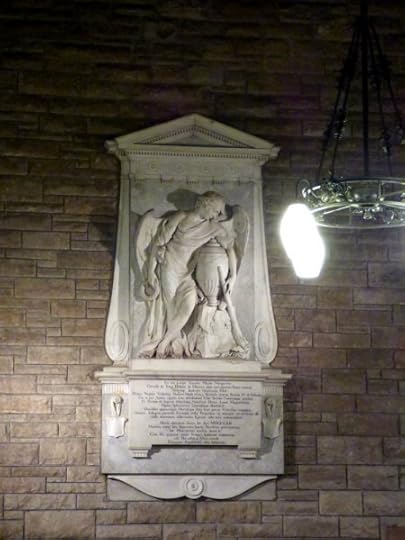 The church is beautiful… very simple and with much history tied up with the family of the Earls of Wemyss. The first thing we were shown was entirely unexpected… you don’t fall over sculptures by Antonio Canova every day … not in village churches anyway. There were other monuments, both incredible and discrete, including a simple plaque to Captain Hon. Walter Charteris, son of the 9th Earl, who was killed whilst serving with the Gordon Highlanders at Balaclava during the Charge of the Light Brigade in 1854.
The church is beautiful… very simple and with much history tied up with the family of the Earls of Wemyss. The first thing we were shown was entirely unexpected… you don’t fall over sculptures by Antonio Canova every day … not in village churches anyway. There were other monuments, both incredible and discrete, including a simple plaque to Captain Hon. Walter Charteris, son of the 9th Earl, who was killed whilst serving with the Gordon Highlanders at Balaclava during the Charge of the Light Brigade in 1854.
 The windows, set deeply in the walls, are small jewels catching the light. Over the altar in the east the stained glass is by Edward Frampton, copied from the Sandro Botticelli painting of the Virgin Adoring the Sleeping Christ, which is in the possession of the Wemyss family. Other windows tell the story of the Life of Jesus. I particularly liked the Ascension… the arms, body and halo, with the light of the Holy Spirit descending seem to echo the Celtic Cross above the altar.
The windows, set deeply in the walls, are small jewels catching the light. Over the altar in the east the stained glass is by Edward Frampton, copied from the Sandro Botticelli painting of the Virgin Adoring the Sleeping Christ, which is in the possession of the Wemyss family. Other windows tell the story of the Life of Jesus. I particularly liked the Ascension… the arms, body and halo, with the light of the Holy Spirit descending seem to echo the Celtic Cross above the altar.
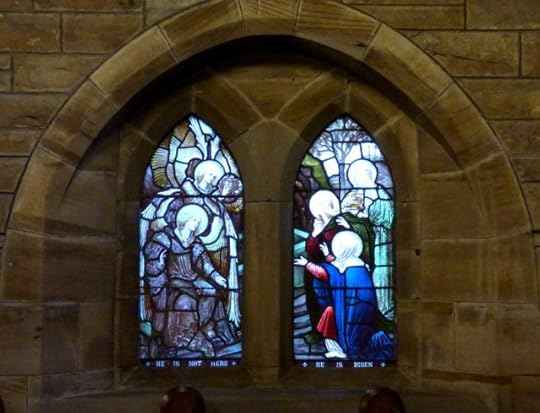 And then of course, there was the stone… just a fragment, and a replica at that. Found in a garden wall in 1863, it is so similar to the nearby cross at Abercorn (which we didn’t know about..) that it is thought the two may be the work of the same craftsman. The back shows the Aberlady Angel, the front four seabirds with their necks and legs entwined forming the familiar ‘Celtic’ geometries. It is strikingly similar to a design in the 8th century Lindisfarne Gospel and may date from this time. Aberlady was on the pilgrim route from Iona to Lindisfarne… Holy Island where we were heading later that day.
And then of course, there was the stone… just a fragment, and a replica at that. Found in a garden wall in 1863, it is so similar to the nearby cross at Abercorn (which we didn’t know about..) that it is thought the two may be the work of the same craftsman. The back shows the Aberlady Angel, the front four seabirds with their necks and legs entwined forming the familiar ‘Celtic’ geometries. It is strikingly similar to a design in the 8th century Lindisfarne Gospel and may date from this time. Aberlady was on the pilgrim route from Iona to Lindisfarne… Holy Island where we were heading later that day.
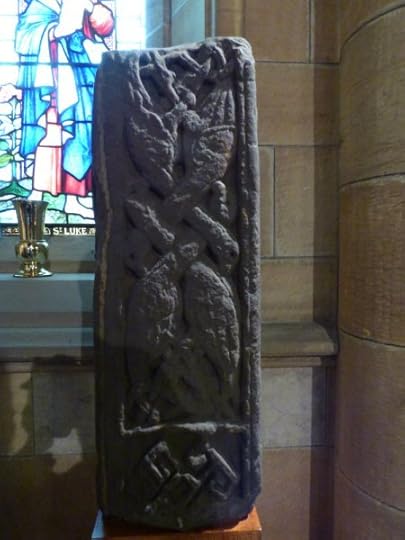 Because of the Abercorn stone and some of the others that we had seen like Ruthwell, it had been possible for a master stonemason Barry Grove, to reconstruct the cross. We could see it in the memorial garden, the Beadle told us as he locked the church door behind us. He was sorry to hurry us… he really shouldn’t still be there… but he would show us the vestry in the base of the bell tower… The low arched ceiling with its trap door to the loft covered a tiny room. The church pewter sat on the windowsill below my favourite of the stained glass. The Beadle showed us the ‘dead locks’… huge padlocks used to secure the newly dead and told of older Beadles sitting guard over the graves, up in the tower, armed with guns to protect the dead from the bodysnatchers.
Because of the Abercorn stone and some of the others that we had seen like Ruthwell, it had been possible for a master stonemason Barry Grove, to reconstruct the cross. We could see it in the memorial garden, the Beadle told us as he locked the church door behind us. He was sorry to hurry us… he really shouldn’t still be there… but he would show us the vestry in the base of the bell tower… The low arched ceiling with its trap door to the loft covered a tiny room. The church pewter sat on the windowsill below my favourite of the stained glass. The Beadle showed us the ‘dead locks’… huge padlocks used to secure the newly dead and told of older Beadles sitting guard over the graves, up in the tower, armed with guns to protect the dead from the bodysnatchers.
 I have said before that we generally prefer to have the little churches we visit to ourselves, Sometimes we fall lucky and meet someone who knows and loves the old buildings, sharing their knowledge and their affection with warmth and a simple pride. These meetings are as much a gift as any of the treasures we fall over. We took a reluctant leave of the old gentleman, following his instructions to see the oldest tomb in the churchyard before going to the memorial garden to see the reconstructed Aberlady Cross.
I have said before that we generally prefer to have the little churches we visit to ourselves, Sometimes we fall lucky and meet someone who knows and loves the old buildings, sharing their knowledge and their affection with warmth and a simple pride. These meetings are as much a gift as any of the treasures we fall over. We took a reluctant leave of the old gentleman, following his instructions to see the oldest tomb in the churchyard before going to the memorial garden to see the reconstructed Aberlady Cross.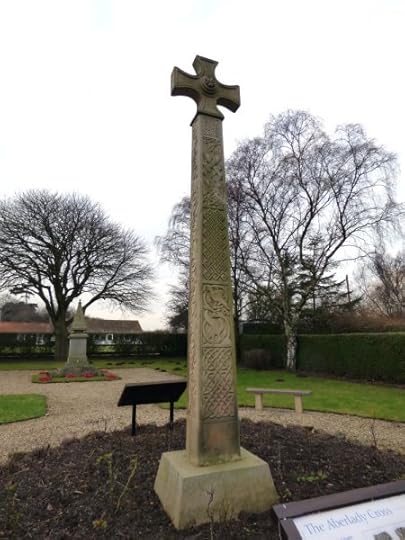

Discovering Albion – day 7: Synchronicity
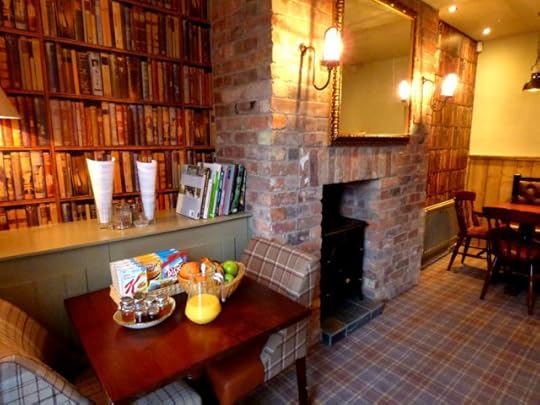 We needed a walk after breakfast. We’d made a start on the fruit and cereals… and there was toast. We may not have bothered had we realised that the plates soon to be delivered would feed the pair of us for a week. We certainly wouldn’t need lunch…Two…or even three.. of everything; all the usual suspects like eggs, bacon grilled tomatoes and sausages… but also potato scone, black pudding and haggis. The Old Aberlady Inn did us proud. We really needed a walk!
We needed a walk after breakfast. We’d made a start on the fruit and cereals… and there was toast. We may not have bothered had we realised that the plates soon to be delivered would feed the pair of us for a week. We certainly wouldn’t need lunch…Two…or even three.. of everything; all the usual suspects like eggs, bacon grilled tomatoes and sausages… but also potato scone, black pudding and haggis. The Old Aberlady Inn did us proud. We really needed a walk!
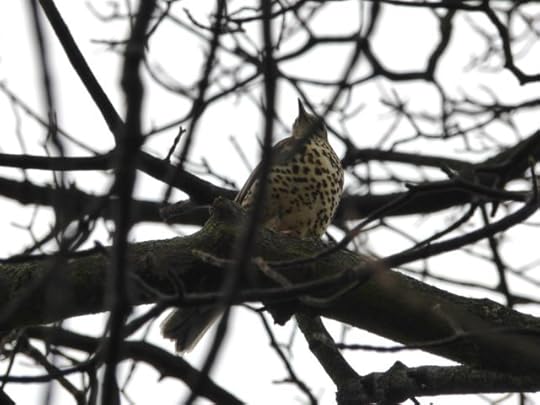 So off we went in search of the 18th century ‘Mercat Cross’ I had seen marked on the board the night before. We hadn’t far to walk… which was probably just as well… before we found it on the main street. We must have passed it in the dark last night. A thrush… a mistle thrush I think… looked down on our activities from an overhanging branch as we walked beyond the worn stones. We had spotted something else.
So off we went in search of the 18th century ‘Mercat Cross’ I had seen marked on the board the night before. We hadn’t far to walk… which was probably just as well… before we found it on the main street. We must have passed it in the dark last night. A thrush… a mistle thrush I think… looked down on our activities from an overhanging branch as we walked beyond the worn stones. We had spotted something else.
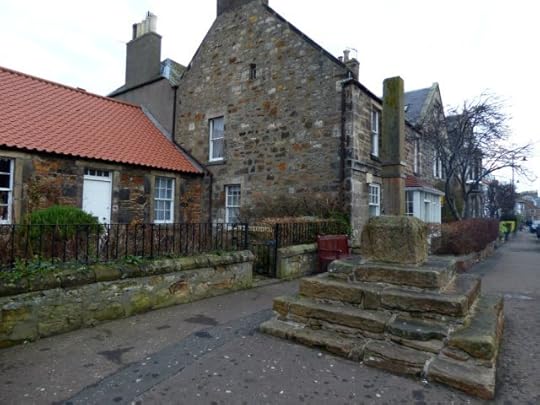 I’d seen something marked called the ‘loupin on stane’. The last word, I had understood, but it wasn’t until I saw the mounting block outside the church that the penny dropped and I understood the rest. Loupin-leaping-looping…stone steps to help those who needed it onto their horses after church. Of course!
I’d seen something marked called the ‘loupin on stane’. The last word, I had understood, but it wasn’t until I saw the mounting block outside the church that the penny dropped and I understood the rest. Loupin-leaping-looping…stone steps to help those who needed it onto their horses after church. Of course!
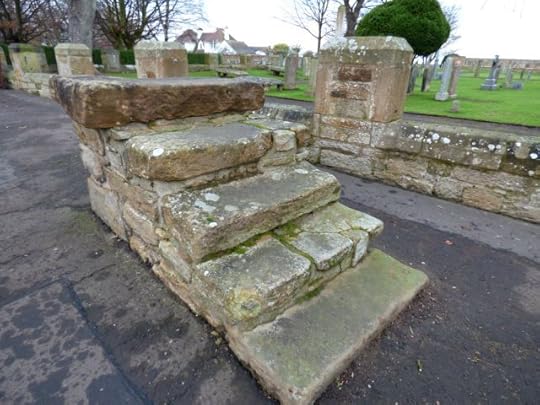 We wandered into the graveyard, looking at the tombs. It was far too early to expect the kirk to be open, even in summer. In January we had no chance. There were a good many stones from the 16th and 17th centuries, as well as the burials of the Earl of Wemyss and his family and a rather curious and weatherworn carving that caught my eye. Probably because of the twin theme again, even though this was only a few hundred years old.
We wandered into the graveyard, looking at the tombs. It was far too early to expect the kirk to be open, even in summer. In January we had no chance. There were a good many stones from the 16th and 17th centuries, as well as the burials of the Earl of Wemyss and his family and a rather curious and weatherworn carving that caught my eye. Probably because of the twin theme again, even though this was only a few hundred years old.
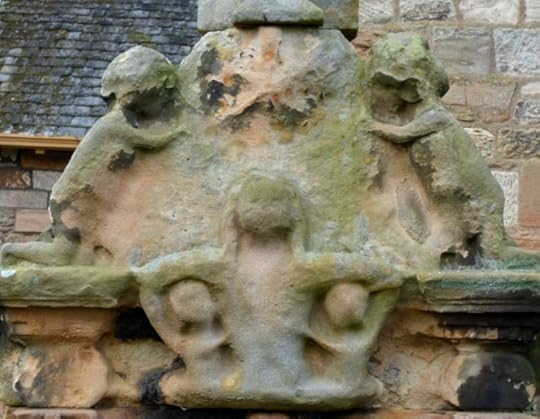 We found more information boards behind the church looking out to sea, telling of the ancient hillfort that had stood here, the castle ruins and the smugglers cave that had, perhaps, once been a souterrain… those enigmatic underground spaces that could have been used for anything from storage to ritual. It was from Aberlady that the mother of St Kentigern who we had first met in Aspatria and kept stumbling across, is said to have been cast adrift in the coracle and there is evidence of yet another Culdee chapel that once stood close to the present church. There was, it seemed, a lot to explore here and, given the welcome we’d had, we would be more than happy to come back.
We found more information boards behind the church looking out to sea, telling of the ancient hillfort that had stood here, the castle ruins and the smugglers cave that had, perhaps, once been a souterrain… those enigmatic underground spaces that could have been used for anything from storage to ritual. It was from Aberlady that the mother of St Kentigern who we had first met in Aspatria and kept stumbling across, is said to have been cast adrift in the coracle and there is evidence of yet another Culdee chapel that once stood close to the present church. There was, it seemed, a lot to explore here and, given the welcome we’d had, we would be more than happy to come back.
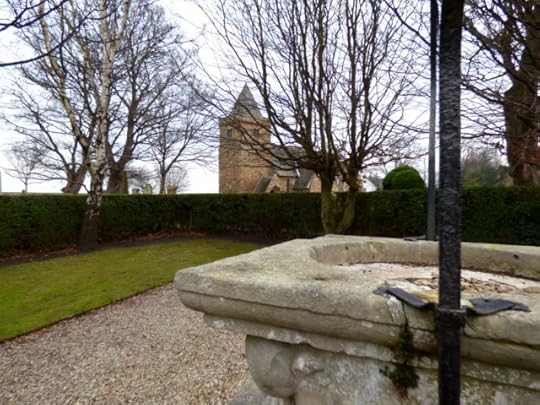 We wandered round to the door… we had to at least try after all. It was locked, of course, but I was looking at a photograph in the porch of the Aberlady High Cross… . We had, it seemed, stumbled across another! Turning to leave we were greeted with a cheery good morning by a gentleman who introduced himself as the Beadle of the kirk. We were lucky, he said. Normally the church wouldn’t be open, but he had just popped along to put the heating on for the cleaners… he turned the key in the lock… Had we come to see the Aberlady carved stone?
We wandered round to the door… we had to at least try after all. It was locked, of course, but I was looking at a photograph in the porch of the Aberlady High Cross… . We had, it seemed, stumbled across another! Turning to leave we were greeted with a cheery good morning by a gentleman who introduced himself as the Beadle of the kirk. We were lucky, he said. Normally the church wouldn’t be open, but he had just popped along to put the heating on for the cleaners… he turned the key in the lock… Had we come to see the Aberlady carved stone?
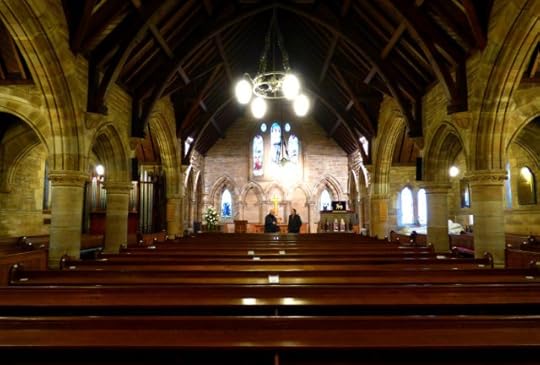 We just looked at each other. A random stop in a random place, guided by the Wemyss Hotel… a random need for a walk right then… and we randomly arrive on the doorstep at just the right time to be allowed in… and given a guided tour…? Even for us that is pushing coincidence a bit! And, apparently, there was a stone…
We just looked at each other. A random stop in a random place, guided by the Wemyss Hotel… a random need for a walk right then… and we randomly arrive on the doorstep at just the right time to be allowed in… and given a guided tour…? Even for us that is pushing coincidence a bit! And, apparently, there was a stone…


